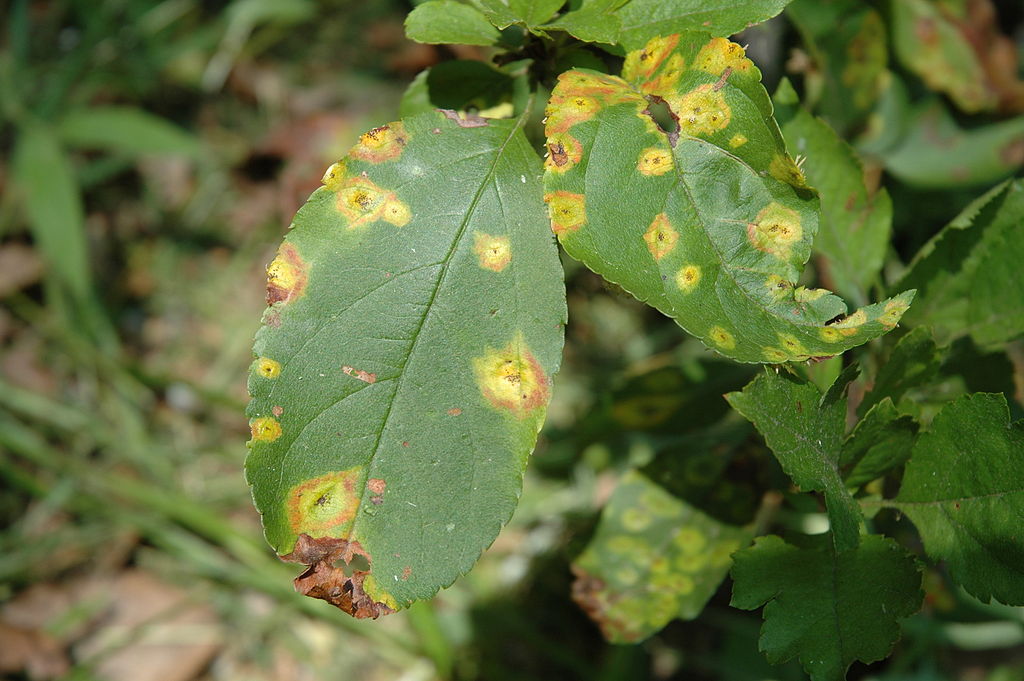Introduction
Cedar-apple rust is a fungal infection that commonly affects junipers, apples, and crabapples. It is caused by a pathogen called Gymonosporangium juniperi-virginianae. Cedar-apple rust requires two hosts to complete its life cycle: a juniper, and an alternative host. During the first stage in its life cycle, the pathogen infects most varieties of eastern red cedar, as well as many other species of juniper. Once this stage has concluded, the pathogen infects an alternative host. Of these alternative hosts, cedar-apple rust primarily affects apples and crabapples. In addition to these plants, quince, hawthorn, mountain-ash, flowering quince, cotoneaster, chokecherry, and photinia can substitute as hosts. Cedar-apple rust is indigenous to North America. It is most prevalent throughout the eastern United States, southern Ontario, and Quebec. The disease is uncommon in the west, though it has been reported in California and Washington.
Disease Cycle
On juniper or eastern red cedar, small galls appear about seven months after infection. Gelatinous masses of spores form after eighteen months. Small depressions form on the gall that cause telial horns to rise the following spring. The telial horns are initially brown, but rapidly elongate and turn bright orange during wet periods in spring. They continue to shrink and swell with intermittent rainfall. Once the horns become sufficiently moist, they release a bevy of rust spores that infect susceptible plants. After releasing their spores, the horns collapse, and become desiccated, eventually falling off. During this phase, galls expire as well, but may remain attached to the juniper for a year or longer.
Rust is most conspicuous on red cedar and other junipers during spring, when the galls are covered with orange-brown gelatinous masses. Circular, yellow lesions appear on the upper surfaces of leaves on apples and crabapples shortly following budburst. As the disease progresses, raised orange structures develop on the undersides of the leaves, just below the yellow lesions. These orange structures ooze from the center, and turn black. In late summer, they produce the orange and rust-colored spores that infect the juniper, completing the cycle.
Extended periods of rain and wind in early spring are conducive to twig, leaf, and fruit infection. Windy conditions help disseminate the spores to nearby plants. Severe storms that occur within the first two weeks of budbreak, and leaf expansion can exacerbate the disease.
Symptoms on Juniper
Small brown galls develop on the needles and twigs of infected junipers. Galls produced by cedar-apple rust are often over two inches in diameter. When mature, the galls swell considerably, and produce orange, gelatinous telial horns. The horns form during early spring, following extended periods of rainfall. As spring transitions to summer, affected twigs may die back; otherwise, no significant damage occurs.
Symptoms on Apple and Crabapple
On apples, and crabapples, infections occur on leaves, fruit, and twigs. Crabapples are generally more susceptible to the disease. Throughout late April and May, circular, yellow lesions appear on the upper surfaces of the leaves. As the lesions mature, they gradually enlarge, turning a yellow-orange color, with a swollen red border. Drops of orange fluid may ooze from the lesions. Some lesions may develop tiny black dots called spermagonia. These can be observed on the orange spots in the center of the lesions.
In mid to late summer, brown clusters of threads, or cylindrical tubes called aecia develop on the undersides of leaves. They may also appear on susceptible fruit and twigs. The spores associated with the threads or tubes infect the needles and twigs of juniper. Severely infected leaves may drop prematurely, especially during periods of extreme heat.
Prevention & Management
- Prune and dispose of galls of junipers prior to the formation of the telial horns.
- When planting, consider using disease resistant varieties. Resistant apple varieties include ‘Freedom’, ‘Grimes Golden’, ‘Jonafree’, ‘Linberty’, ‘Narragansett’, ‘Priscilla’, ‘Red Delicious’, ‘Redfree’, ‘Staymans’, ‘William’s Pride’, and ‘Winesap’. Varieties of crabapple that are resistant to cedar-apple rust include ‘Adams’, ‘Beverly’, ‘Candied Apple’, ‘Dolgo’, ‘Donald Wyman’, ‘Eleyi’, ‘Inglis’, ‘Indian Summer’, ‘Liset’, ‘Mt. Arbor’, ‘Red Jewel’, ‘Robinson’, ‘Robusta’, ‘Royalty’, ‘Tina’, ‘Snowdrift’, and ‘Special Radiant’. Susceptible varieties include ‘Golden Delicious’, ‘Jonathan’, ‘Rome Beauty’, ‘Wealthy’, and ‘York Imperial’. Avoid planting juniper and rust-susceptible hosts in close proximity.
- Fungicide sprays are highly effective against cedar-apple rust. Applications to junipers can be made before and while they are in the orange gelatinous state. This will reduce the severity of the outbreak.
- Fungicide applications to apples and crabapples will help protect them from the infectious spores released during mid to late spring. Initial applications should be administered at budbreak. Three subsequent applications can be made at seven to ten day intervals.
- Pesticides can be applied on junipers in July and August to reduce infection. Some of the pesticides registered for use include captan, chlorothalonil, copper, mancozeb, maneb, sulfur, thiophanata methyl, thiram, triadimefon, and ziram.


